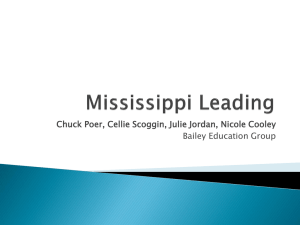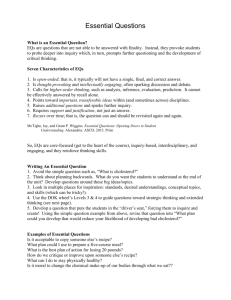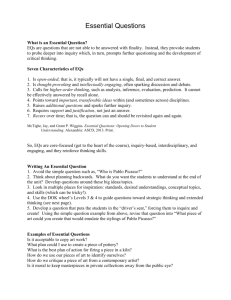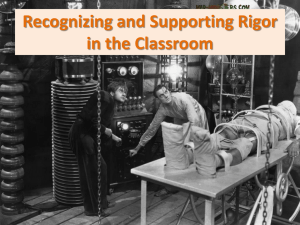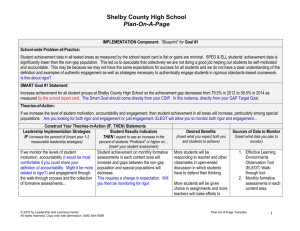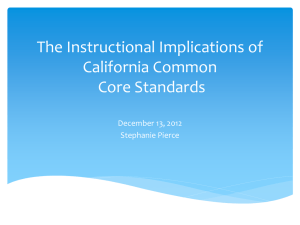Using Student Data to Make Informed Instructional Decisions Alice
advertisement
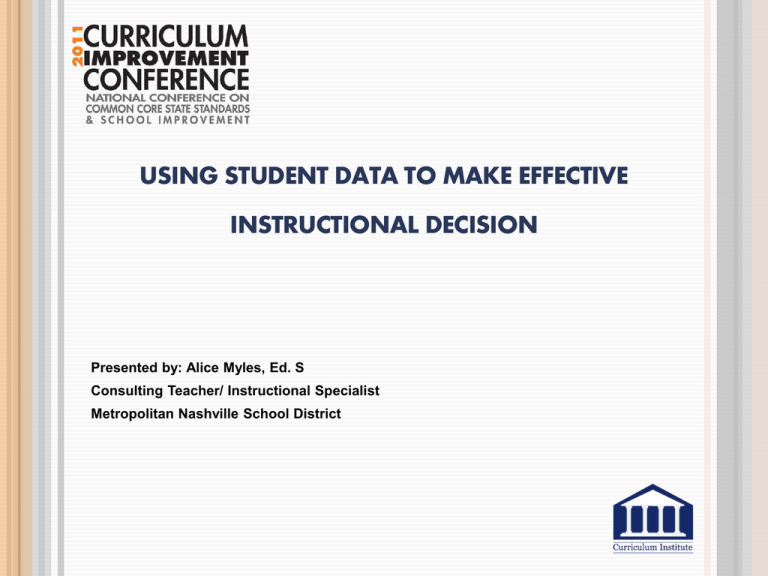
USING STUDENT DATA TO MAKE EFFECTIVE INSTRUCTIONAL DECISION Presented by: Alice Myles, Ed. S Consulting Teacher/ Instructional Specialist Metropolitan Nashville School District WELCOME TO COMMON CORE STANDARDS TRAINING! Greet the members of your team and introduce yourself. TODAY YOU WILL LEAVE WITH…. An understanding of Common Core State Standards (CCSS) Vocabulary related to unpacking the Common Core State Standards Knowledge of how to use formative and summative assessments to inform instructional decisions in the classroom. COMMON CORE STATE STANDARDS ACTIVITY #1 Using Handout #1 complete the Common Core Standards Pre-test. Please work with a person on your team COMMON CORE STATE STANDARDS OVERVIEW Common Core Standards are… Common Core Standards are not.. UNWRAPPING THE STANDARDS Making the standards manageable, rigorous, and relevant to classroom instruction. KEYS TO UNWRAPPING THE STANDARDS • Introduce the standards as both a bottom –up and top down initiative. • Involve a critical mass of teachers nationwide from the first day the project moves into schools. •Focus on results rather than means •Standards have a stronger integrated literacy structure than most state standards •Stringent readability ranges for each grade level •Balance of literature and informational texts •Text Complexity COMMON CORE CHARACTERISTICS Fewer and more rigorous. Aligned with college and career expectations Internationally benchmarked Rigorous content and application of higher-order skills. Builds on strengths and lessons of current state standards. Research based COMMON CORE STATE STANDARDS ACTIVITY #2 PROTOCOL: TEXT RENDERING 1. Choose a document to review. 2. Take 5 minutes to review the document you chose, mark one sentence, a phrase, and a word that you think is particularly important for our work with the Common Core State Standards. 3. Prepare to share your sentences, your phrases and then your words with your team. COMMON CORE STANDARDS: ELA/LITERACY Three main sections K−5 (cross-disciplinary) • K-2 focus on Foundation Skills for print concepts and phonological awareness • K-5 phonics and word recognition, and fluency 6−12 English Language Arts 6−12 Literacy in History/Social Studies, Science, and Technical Subjects Shared responsibility for students’ literacy development COMMON CORE STANDARDS: ELA •Standard levels that will be new for reporting purposes across all vendor assessments. •Grade ranges for ELA, separate list of developmentally appropriate skills aligned with the College and Career Readiness Standards. The mathematics document doesn’t have this. •ELA standards have a Strand, Cluster, and a Standard. COMMON CORE MATH STANDARDS Handout #3 K-8 Grade Domain Cluster Standards (There are no Pre-K Common Core Standards) QUIZ / QUIZ / TRADE 1. 2. 3. 4. 5. Each person takes one card. Pair with someone you don’t know. One person quizzes the other person and then vice-versa. The person with the shorter hair of the pair will always go first. Trade cards, and raise your hands. Find a new person, and repeat the process. (10) MENU FOR RIGOR IN THE CLASSROOM Demanding Relevant Engaging Addressing different learning styles Self-challenging Adaptive DEFINING RIGOR AND WHAT IT LOOKS LIKE Academic rigor can be defined as the set of standards we set for our students and the expectations we have for our students and ourselves. Rigor is much more than assuring that the course content is of sufficient difficulty to differentiate it from K-12 level work. Rigor includes our basic philosophy of learning – we expect our students to demonstrate not only content mastery, but applied skills and critical thinking about the disciplines being taught. Rigor also means that we expect much from ourselves, our colleagues, and our institutions of learning. COMPONENTS OF RIGOR Assists students in fulfilling predetermined outcomes and competencies by challenging them with high expectations. Essential components of rigor in the classroom: •Content acquisition •Critical thinking •Relevance •Integration •Application of concepts •Long term retention •Responsibility EXAMINING RIGOR IN STUDENT ASSIGNMENTS Activity #3 Using the Common Core State Standards design a performance task for students at each grade level. Data data everywhere So much it's hard to think. Data data everywhere If only it would link. James Turner, Educator THE IMPORTANCE OF STUDENT DATA •What is Data???? •Discuss your definition of data with your group. Compile a list of types of data you would collect regarding students. Choose one person to serve as the presenter for the group. THE IMPORTANCE OF DATA Data is collected to inform instructional decisions in a classroom, school, or school district. Data includes factual informal information about students. Data includes academic, social, and behavioral facts about students. Data is the first step in planning in your classroom. THE IMPORTANCE OF DATA Data leads to a teacher being able to: • Reflect on own practices • Generate new strategies to reach students • Make practical educational decisions • Meet the needs of individual student’s learning styles • Determine and reevaluate previous decisions for effectiveness • Ultimately, be a more engaged, effective, productive, confident, and happy educator Gall, Joyce P. and M.D., Borg, Walter R. Applying Educational Research: A Practical Guide. NY: Longman, 1999. LEVELS OF DATA State Level District Level School Level Grades levels making AYP School Report Card Data Diagnostic Data Schools AYP data High Stakes testing data School Discipline data School Attendance Data AYP data, # of students receiving free and reduced lunch, and student receiving exceptional education services CLASSROOM LEVELS •Individual Student Scores •Anecdotal observations •Student interest, motivations •Behavioral Observations •Parent Conference Data GROUP ACTIVITY #3 DATA CONVERSATION Work with your group to examine the different types data Draw conclusion for student instruction based on the information given in the profile. Work in pairs to engage in a data conversation. One person will act as the teacher and one person will act as the administrator, instructional coach, or team member. Discuss the possible decisions that can be made to improve classroom instruction to increase student achievement. CREATING COMMUNITY Professional Learning Community DATA DRIVEN CULTURE Eight Steps for Success 1. Establish a Clear Vision 2. Research and Learn from Others’ Successes 3. Examine Infrastructure for Effective Data Use 4. Ensure Buy-In, Commitment and Trust 5. Foster Professional Development 6. Lead by Example and Encourage Data Utilization 7. Establish Data Meetings 8. Remove or Modify Barriers to Effective Data Use Questions? CONTACT INFORMATION: ALICE MYLES, ED.S MYLES.ALICE@YAHOO.COM ALICE.MYLES@MNPS.ORG

